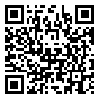Volume 18, Issue 3 (Vol.18, No.3, Autumn 2022)
irje 2022, 18(3): 177-186 |
Back to browse issues page
Download citation:
BibTeX | RIS | EndNote | Medlars | ProCite | Reference Manager | RefWorks
Send citation to:



BibTeX | RIS | EndNote | Medlars | ProCite | Reference Manager | RefWorks
Send citation to:
Soori H, Khodakarami N, Zali A, Noori A, Akbarpour S, Asgarian F S. A Study of the Epidemiology of COVID-19 in the City of Tehran, Iran. irje 2022; 18 (3) :177-186
URL: http://irje.tums.ac.ir/article-1-6586-en.html
URL: http://irje.tums.ac.ir/article-1-6586-en.html
Hamid Soori * 
 1, Nahid Khodakarami2
1, Nahid Khodakarami2 
 , Alireza Zali3
, Alireza Zali3 
 , Alireza Noori4
, Alireza Noori4 
 , Samaneh Akbarpour5
, Samaneh Akbarpour5 
 , Fatemeh Sadat Asgarian6
, Fatemeh Sadat Asgarian6 


 1, Nahid Khodakarami2
1, Nahid Khodakarami2 
 , Alireza Zali3
, Alireza Zali3 
 , Alireza Noori4
, Alireza Noori4 
 , Samaneh Akbarpour5
, Samaneh Akbarpour5 
 , Fatemeh Sadat Asgarian6
, Fatemeh Sadat Asgarian6 

1- Professor of Epidemiology, Safety Promotion and Injury Prevention Research Center, Shahid Beheshti University of Medical Sciences, Tehran, Iran , hsoori@yahoo.com
2- Men's Health and Reproductive Research Center, Shahid Beheshti University of Medical Sciences, Tehran, Iran
3- Professor of Neurosurgery, Applied Neurology Research Center, Shahid Beheshti University of Medical Sciences, Tehran, Iran
4- Tehran Urban Research and Planning Center (TURPC), Tehran, Iran
5- PhD in Epidemiology, Occupational Sleep Disorders Research Center, Tehran University of Medical Sciences, Tehran, Iran
6- Social Determinants of Health (SDH) Research Center, Kashan University of Medical Sciences, Kashan, Iran
2- Men's Health and Reproductive Research Center, Shahid Beheshti University of Medical Sciences, Tehran, Iran
3- Professor of Neurosurgery, Applied Neurology Research Center, Shahid Beheshti University of Medical Sciences, Tehran, Iran
4- Tehran Urban Research and Planning Center (TURPC), Tehran, Iran
5- PhD in Epidemiology, Occupational Sleep Disorders Research Center, Tehran University of Medical Sciences, Tehran, Iran
6- Social Determinants of Health (SDH) Research Center, Kashan University of Medical Sciences, Kashan, Iran
Abstract: (1022 Views)
Background and Objectives: COVID-19 pandemic caused a lot of severe problems in the world. This study investigated the epidemiology of the disease in Tehran in the first quarter of the epidemic's beginning.
Methods: The available information recorded for patients from 20 February 2020 to 20 May 2020 in Tehran was used. To prepare disease-related distribution maps, the addresses of patients' residences in Google Earth were called to ARC-GIS version 10-4. The methods used in GIS include IDW, Hotspot and also software development.
Results: Overall, 3699 individuals whose PCR results were positive in Tehran were included in the study. Out of the total number of them, 550 people died and the fatality rate of the disease in hospitalized patients was 14.9%. One thousand five hundred thirty patients (41.4%) have recovered, and the remaining 1619 patients were under treatment until data collection. Of the total, 1479 confirmed cases were women (40%). The average age was 57.4 years (SD=16.5). The density of cases in areas 4, 8 and 13, and the existence of some cluster diseases in neighborhoods such as Tehran Pars, Ayat and Pirouzi streets are noteworthy points.
Conclusion: The trend of the COVID-19 epidemic is dire and requires long-term measures. Nevertheless, to control this disease, the health system, the policy of isolating patients and suspicious people, wear masks especially in densely populated areas, are the most important controlling factors.
Methods: The available information recorded for patients from 20 February 2020 to 20 May 2020 in Tehran was used. To prepare disease-related distribution maps, the addresses of patients' residences in Google Earth were called to ARC-GIS version 10-4. The methods used in GIS include IDW, Hotspot and also software development.
Results: Overall, 3699 individuals whose PCR results were positive in Tehran were included in the study. Out of the total number of them, 550 people died and the fatality rate of the disease in hospitalized patients was 14.9%. One thousand five hundred thirty patients (41.4%) have recovered, and the remaining 1619 patients were under treatment until data collection. Of the total, 1479 confirmed cases were women (40%). The average age was 57.4 years (SD=16.5). The density of cases in areas 4, 8 and 13, and the existence of some cluster diseases in neighborhoods such as Tehran Pars, Ayat and Pirouzi streets are noteworthy points.
Conclusion: The trend of the COVID-19 epidemic is dire and requires long-term measures. Nevertheless, to control this disease, the health system, the policy of isolating patients and suspicious people, wear masks especially in densely populated areas, are the most important controlling factors.
Type of Study: Research |
Subject:
Epidemiology
Received: 2020/09/20 | Accepted: 2023/01/11 | Published: 2022/12/1
Received: 2020/09/20 | Accepted: 2023/01/11 | Published: 2022/12/1
Send email to the article author
| Rights and permissions | |
 |
This work is licensed under a Creative Commons Attribution-NonCommercial 4.0 International License. |



